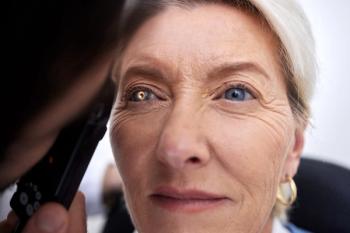
Removing complex cataracts at advanced surgery center
The Medical University of South Carolina offers brand new, state-of-the-art surgery center dedicated solely to ophthalmic procedures.
Ophthalmologists at the Medical University of South Carolina (MUSC) have a brand new, state-of-the-art surgery center that is dedicated solely to ophthalmic procedures.
“The operating rooms (ORs) as well as our nursing and anesthesia staff are all focused on eye surgery. So, in terms of whole patient care, from the moment a patient walks in the door, to the nurse in pre-op, to the OR team, to discharge, patients are seen by dedicated ophthalmology staff,” said Lynn Perry, MD, assistant professor of ophthalmology at the MUSC Health Storm Eye Institute.
This dedicated surgery center is much needed, considering that over 4 million adults in the US have low vision or are legally blind, and cataracts are the leading cause of blindness both nationally and worldwide.1
Cataracts, which are cloudy areas in the lens of the eye, affect an estimated 20-30 million Americans, and, in most cases, can be surgically removed.2
“Everyone gets cataracts as they get older,” said Perry, who specializes in treating a range of conditions that can cause vision loss, including cataracts and uveitis (inflammatory eye disease). “Routine cataract removal is the most common procedure, but we also perform less common procedures for other conditions involving the lens or complicated cataracts.”
Perry specializes in removing cataracts due to uveitis, which are particularly challenging to treat successfully.
“Cataracts are part of the uveitis disease process. Both the chronic inflammation from the disease and the steroids that are used to treat the disease speed up cataract formation,” Perry said. “Treating these patients can be challenging and complex. They can have a lot of scarring in the eye that makes the cataract harder to remove, and they need more specialized management before, during, and after their surgery.”
Preparations for cataract removal in uveitis begins several months in advance. Prior to cataract removal, inflammation must be well controlled for at least three months using immunosuppressant medications and/or topical, periocular, or systemic steroids.3,4
An in-depth work-up is also needed to identify any structural complications that may block the surgeon’s view of the operating field, such as posterior synechiae (adhesion of the iris to the lens).5Surgeons also need to know if there are any other conditions such as lens instability that they may need to manage intraoperatively.6,7
Uveitis inflammation can also be inconsistent, and fluctuations in macular swelling can alter essential measurements and change calculations for the new intraocular lens (IOL) being placed.8
Ideally, the new lens is placed inside the capsular bag, but chronic inflammation can destabilize it, meaning surgeons have to be proficient in using capsular hooks and tension rings to facilitate the procedure.
“Even though uveitis is a fairly common problem, it makes treating cataracts more complex,” Perry said. “It takes additional surgical techniques while the patient is in the OR, and we have to manage the inflammation both before and after surgery to get the best results.”
That level of care takes a dedicated team of experts to guide each patient from their pre-operative preparation through their post-operative recovery.
In other cases, the lens may be dislocated and need to be removed and replaced to restore normal vision. “Severe trauma to eye can make the lens fall out of place, or a genetic disease can weaken the support structure for the lens,” Perry said.
With a comprehensive team of ophthalmic specialists, patients can have multiple issues treated in a single surgery that may require two surgeries elsewhere. For example, Perry, who specializes in anterior eye surgeries, often collaborates with retina surgeons who work in the back of the eye.
“We get a number of referrals for patients who need a scleral fixated lens, because some practices are not comfortable doing those,” Perry said.
This procedure, which can be sutured or suture-less, is indicated when there is no capsular or iris support for the new lens being placed.9
“When a patient has a lens that has fallen out of position to the back of the eye, we team up to work on both areas in one surgery. A retina surgeon will first remove the dislocated lens from the back of the eye, and then I’ll implant the new, scleral fixated lens in the front of the eye,” Perry said. “Not everywhere has access to retina surgeons, so they can’t do both parts of the surgery at the same time. In those places, the patient has to have two surgeries with the retina part first. Then, after they recover from that, they come back for the lens procedure.”
Having the latest equipment in a dedicated facility that offers the full spectrum of eye surgery is a healthcare resource for patients across South Carolina. But the people who work here are what really sets it apart.
“When patients come in for their postop visit, they always talk about how amazing the staff were during their surgery,” Perry said. “Our nurses are really so happy to be here. It’s a great environment for healthcare, and that’s evident to our patients.”
To make an appointment or refer a patient to the MUSC Health Storm Eye Institute, please call (843) 792-2020.
References
1. Centers for Disease Control & prevention. Common Eye Disorders. Accessed June 16, 2022. https://www.cdc.gov/visionhealth/basics/ced/index.html#:~:text=An%20estimated%2020.5%20million%20(17.2,Learn%20more%20about%20cataracts%20.
2. Centers for Disease Control & Prevention. Common Eye Disorders. Accessed June 16, 2022. https://www.cdc.gov/visionhealth/basics/ced/index.html#:~:text=An%20estimated%2020.5%20million%20(17.2,Learn%20more%20about%20cataracts%20.
3. Chan NS, Ti SE, Chee SP. Decision-making and management of uveitic cataract. Indian J Ophthalmol. 2017;65(12):1329-1339. doi:10.4103/ijo.IJO_740_17
4. Larochelle M. University of Utah Health. Combining Cataract and Uveitis Care. March 1, 2021. Accessed June 16, 2022. https://healthcare.utah.edu/moran/news/physician-consult/2021/uveitis-cataracts.php
5. Columbia University Department of Ophthalmology. Posterior Synechiae. Accessed June 16, 2022. https://www.columbiaeye.org/education/digital-reference-of-ophthalmology/cornea-external-diseases/non-infectious/posterior-synechiae
6. Chan NS, Ti SE, Chee SP. Decision-making and management of uveitic cataract. Indian J Ophthalmol. 2017;65(12):1329-1339. doi:10.4103/ijo.IJO_740_17
7. Larochelle, M. University of Utah Health. Combining Cataract and Uveitis Care. March 1, 2021. Accessed June 16, 2022. https://healthcare.utah.edu/moran/news/physician-consult/2021/uveitis-cataracts.php
8. Larochelle, M. University of Utah Health. Combining Cataract and Uveitis Care. March 1, 2021. Accessed June 16, 2022. https://healthcare.utah.edu/moran/news/physician-consult/2021/uveitis-cataracts.php
9. Stem MS, Todorich B, Woodward MA, Hsu J, Wolfe JD. Scleral-Fixated Intraocular Lenses: Past and Present. J Vitreoretin Dis. 2017;1(2):144-152. doi:10.1177/2474126417690650
Newsletter
Want more insights like this? Subscribe to Optometry Times and get clinical pearls and practice tips delivered straight to your inbox.



















































.png)


